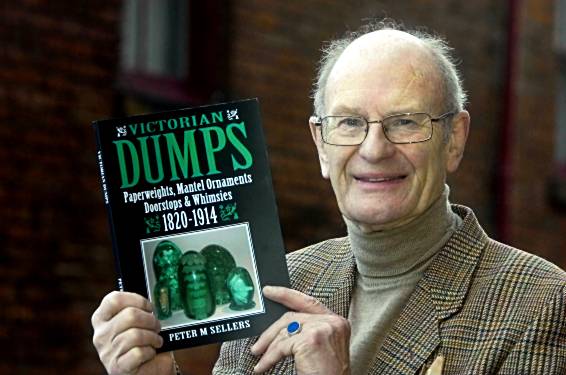Rare hobby sparks worldwide interest
Reporter: Marina Berry
Date published: 12 February 2010
YOU could be forgiven for asking what on earth these little glass ornaments are, yet a century ago they were very common throughout the North of England and the Midlands.
Dumps, as they are known, were the remnants of the day’s work which took place in glass-making factories, and were destined for the dumping bin.
Poorly paid yet highly skilled workers who laboured 12 hours a day to hand-make glass bottles could help themselves to the dumps.
They used them to make a variety of things, from paperweights and doorstops, to mantel ornaments and all things whimsical.
Largely made out of bottle green glass, dumps ended up in far-flung parts of the globe, from New Zealand and Australia to the United States, possibly taken by English immigrants who wanted to take with them a little piece of home.
Saddleworth couple Peter and Min Sellers discovered dumps 10 years ago when they spotted them in antique and second-hand shops.
It sparked an interest which turned into a passion, and a longing by Mr Sellers to find out more about where they came from.
“I searched everywhere looking for information, but no-one knew much about them, not even the dealers who were selling them,” he said.
The hunt resulted in the grandfather-of-three coming across the world’s biggest dump collector, William Drew Gaskill, who lived in California.
The couple attended one of his lectures when he came to England seven years ago, and learned how workers used their skills to turn dumps into beautiful, smooth, glass objects.
Many contained figures made from clay, or flowers created from the silver paper out of cigarette packets.
“Bill told me he was going to write the first ever book on dumps, but he died suddenly the following year, when he was 57,” said Mr Sellers.
He wrote to Mr Gaskill’s family expressing his sorrow, both about his death and the fact his book would never be written. They suggested he write it instead.
The family gave Mr Sellers stories written by Mr Gaskill to give him a start. Then a busy four years of research followed. The search took in museums, galleries and archives.
Mr Sellers said: “We met some marvellous people.”
Once 10-a-penny, many dumps have been smashed, thrown away and wrecked by being used as hammers. They are now collectors’ items.
With his book finished — the first ever on Victorian dumps, which were made only between 1820 and 1914, Mr Sellers forked out £3,000 to have 150 copies printed.
The fact it is the only book documenting the history and making of dumps, makes the 78-year-old former chartered surveyor a world authority on the subject.
Just over a month after publication, 60 copies have already been sold in the UK and 25 more overseas.
“I couldn’t believe it, I had 150 printed thinking they would last me all my life,” he laughed.
The 133-page book has 130 photographs of fully described examples which include many rare and unique dumps, many from the late Mr Gaskill’s collection.
“People buy dumps on eBay so I put the book on there — now I have two files full of e-mails from all over the world. It seems collectors have been looking for a book forever,” he said.
Such is his renown in the field, Mr Sellers has been invited to sign his books at the Cambridge Glass Fair — the biggest in the country — on February 28.
The book, priced £39, is available only from the author. Details under eBay selling section “Victorian Paperweights”.
Most Viewed News Stories
- 1Police issue appeal after woman dies after being found unconscious on road on Oldham/Tameside
- 2Former pub ‘left to rot’ for years is finally demolished
- 3‘New’ town hall due to open to public for first time after full cost of major refurb project...
- 4‘Overpaid’ councillors speak out after payment error
- 5Oldham woman evicted by FCHO





